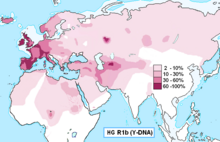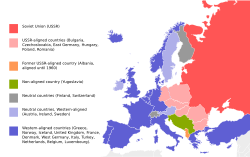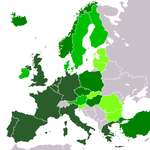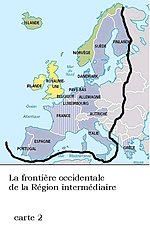Western Europe: Difference between revisions
→United Nations geoscheme: However... |
Swapping the image. Why? 1. Image needs to be based on research paper. 2. R1b is not an exclusively European haplogroup, therefore global context for the Old World is required. |
||
| Line 2: | Line 2: | ||
[[File:Western Europe.ogv|alt=View of the earth from space|thumb|Video taken by the crew of [[Expedition 29]] on board the [[International Space Station|ISS]] on a pass over Western Europe]] |
[[File:Western Europe.ogv|alt=View of the earth from space|thumb|Video taken by the crew of [[Expedition 29]] on board the [[International Space Station|ISS]] on a pass over Western Europe]] |
||
[[File: |
[[File:Haplogroup R1b (Y-DNA).PNG|thumb|R1b is the most common haplogroup amid Western Europeans.<ref>http://www.scs.illinois.edu/~mcdonald/WorldHaplogroupsMaps.pdf</ref><ref>http://www.eupedia.com/europe/european_y-dna_haplogroups.shtml</ref>]] |
||
'''Western Europe''' is the region comprising the ''westerly countries'' of [[Europe]]. While the term has a geographic or cultural context, another main definition developed during the [[Cold War]] (approx. 1945-1991) to describe the countries associated with the [[Western European Union]] (1954–2011; now part of the [[European Union]] (EU)), a defensive alliance drafted in 1948 among non-communist European nations during the Cold War, as opposed to the countries of the [[Eastern Bloc]] (or [[Warsaw Pact]]). Countries [[Culture of Europe|culturally]] and [[Geography of Europe|geographically]] associated with other European regions that avoided [[Soviet Empire|Soviet influence]] during the Cold War are usually included, while western members of the former Eastern Bloc (with the exception of [[Eastern Germany]]) are excluded.{{citation needed|date=May 2012}} This is despite the fact that some of these countries belong to [[Western Civilization]] influenced by [[Western Christianity]], and have shared history with Western European countries for centuries as a part of the [[Frankish Empire]] and the [[Holy Roman Empire]]. |
'''Western Europe''' is the region comprising the ''westerly countries'' of [[Europe]]. While the term has a geographic or cultural context, another main definition developed during the [[Cold War]] (approx. 1945-1991) to describe the countries associated with the [[Western European Union]] (1954–2011; now part of the [[European Union]] (EU)), a defensive alliance drafted in 1948 among non-communist European nations during the Cold War, as opposed to the countries of the [[Eastern Bloc]] (or [[Warsaw Pact]]). Countries [[Culture of Europe|culturally]] and [[Geography of Europe|geographically]] associated with other European regions that avoided [[Soviet Empire|Soviet influence]] during the Cold War are usually included, while western members of the former Eastern Bloc (with the exception of [[Eastern Germany]]) are excluded.{{citation needed|date=May 2012}} This is despite the fact that some of these countries belong to [[Western Civilization]] influenced by [[Western Christianity]], and have shared history with Western European countries for centuries as a part of the [[Frankish Empire]] and the [[Holy Roman Empire]]. |
||
Revision as of 01:08, 12 March 2015

Western Europe is the region comprising the westerly countries of Europe. While the term has a geographic or cultural context, another main definition developed during the Cold War (approx. 1945-1991) to describe the countries associated with the Western European Union (1954–2011; now part of the European Union (EU)), a defensive alliance drafted in 1948 among non-communist European nations during the Cold War, as opposed to the countries of the Eastern Bloc (or Warsaw Pact). Countries culturally and geographically associated with other European regions that avoided Soviet influence during the Cold War are usually included, while western members of the former Eastern Bloc (with the exception of Eastern Germany) are excluded.[citation needed] This is despite the fact that some of these countries belong to Western Civilization influenced by Western Christianity, and have shared history with Western European countries for centuries as a part of the Frankish Empire and the Holy Roman Empire.
The United Nations (UN) Statistics Division considers Western Europe to consist of just nine countries, although the United Nations Regional Groups include European countries from the UN-designated Northern and Southern Europe in its Western European and Others Group.
Capitalisation
The terms "Western Europe" and "western Europe" are used interchangeably, but their meanings are generally different. In the English language, if it is used with a miniscule, it denotes geographical meaning, "a reference to a geographical direction or an area within a country". If capitalised, it is generall a "reference to a major region or in a political context".[3]
The Guardian uses only "western Europe" in its editorial editions, while also recognising the term "central Europe" and "eastern Europe"[4]
Historical divisions
Classical antiquity and medieval origins

Prior to the Roman conquest, a large part of Western Europe had adopted the fairly newly developed La Tène culture. As Roman domain expanded, a cultural and linguistic division appeared between the mainly Greek-speaking eastern provinces which had formed the highly urbanized Hellenistic civilization and the western territories, which, in contrast, largely adopted the Latin language. This cultural and linguistic division was eventually reinforced by the later political east-west division of the Roman Empire.
The division between these two was enhanced during Late Antiquity and the Middle Ages by a number of events. The Western Roman Empire collapsed starting the Early Middle Ages. By contrast, the Eastern Roman Empire, mostly known as the Greek or Byzantine Empire, managed to survive and even to thrive for another 1000 years. The rise of the Frankish Empire in the west, and in particular the Great Schism that formally divided Eastern Orthodoxy and Roman Catholicism, enhanced the cultural and religious distinctiveness between Eastern and Western Europe.
The conquest of the Byzantine Empire, center of the Eastern Orthodox Church, by the Muslim Ottoman Empire in the 15th century, and the gradual fragmentation of the Holy Roman Empire (which had replaced the Frankish Empire) led to a change of the importance of Roman Catholic/Protestant vs. Eastern Orthodox concept in Europe.
Western Europe's significant historical events include the Renaissance, the Age of Discovery, the Protestant Reformation by Martin Luther and the Counter-Reformation of the Catholic Church, the Age of Enlightenment, the French Revolution and the Industrial Revolution.
Cold War

During the final stages of World War II the future of Europe was decided between the Allies in the 1945 Yalta Conference, between the British Prime Minister, Winston Churchill, the U.S. President, Franklin D. Roosevelt, and the Premier of the Soviet Union, Joseph Stalin.
Post-war Europe would be divided into two major spheres: the West, influenced by the United States, and the Eastern Bloc, influenced by the Soviet Union. With the onset of the Cold War, Europe was divided by the Iron Curtain.
This term had been used during World War II by German Propaganda Minister Joseph Goebbels and later Count Lutz Schwerin von Krosigk in the last days of the war; however, its use was hugely popularised by Winston Churchill, who used it in his famous "Sinews of Peace" address on 5 March 1946 at Westminster College in Fulton, Missouri:
From Stettin in the Baltic to Trieste in the Adriatic an iron curtain has descended across the Continent. Behind that line lie all the capitals of the ancient states of Central and Eastern Europe. Warsaw, Berlin, Prague, Vienna, Budapest, Belgrade, Bucharest and Sofia; all these famous cities and the populations around them lie in what I must call the Soviet sphere, and all are subject, in one form or another, not only to Soviet influence but to a very high and in some cases increasing measure of control from Moscow.
Although some countries were officially neutral, they were classified according to the nature of their political and economic systems. This division largely defined the popular perception and understanding of Western Europe and its borders with Eastern Europe till this day.
The world changed dramatically with the fall of the Iron Curtain in 1989. The Federal Republic of Germany peacefully absorbed the German Democratic Republic, in German reunification. COMECON and the Warsaw Pact were dissolved, and in 1991, the Soviet Union ceased to exist. Several countries which had been part of the Soviet Union regained full independence.
Although the term Western Europe was more prominent during the Cold War, it remains much in use. The term commonly appears in the media and in everyday use, in "western" and other regions of Europe.
Western European Union

In 1948 the Treaty of Brussels was signed between Belgium, France, Luxembourg, the Netherlands and the United Kingdom. It was further revisited in 1954 at the Paris Conference, when the Western European Union was established. It was declared defunct in 2011, after the Treaty of Lisbon, and the Treaty of Brussels was terminated. When the Western European Union was dissolved, it had 10 member countries, 6 associate member countries, 5 observer countries and 7 associate partner countries.
Intermediate Region

The Intermediate Region is an established geopolitical model set forth in the 1970s by the Greek historian Dimitri Kitsikis. Under this model, the lands between the Adriatic Sea and the Indus River form the Intermediate Region, and are considered a bridge between Western and Eastern civilisations.
United Nations Statistics Division geoscheme
The United Nations geoscheme is a scheme devised by the United Nations Statistics Division based on the M49 coding classification, which divides the world into macro-geographical regions and subregions.[5] The geoscheme for Europe is divided into 4 groups: Eastern Europe, Northern Europe, Southern Europe and Western Europe. Western Europe consists of 9 countries:
However, this geoscheme is not necessarily used in other agencies of the UN, including UNHCR[6]
Western European and Others Group
The Western European and Others Group is one of several unofficial Regional Groups in the United Nations that act as voting blocs and negotiation forums. Regional voting blocs were formed in 1961 to encourage voting to various UN bodies from different regional groups.
|
|
United Nations Statistics Division
The United Nations Statistics Division published in 2011 considers Western Europe to consist of the following countries,[7] except in the case of United Nations Regional Groups, in which the term also includes northern and Southern Europe:
According to the UN Statistics Division, the assignment of countries or areas to specific groupings is for statistical convenience and does not imply any assumption regarding political or other affiliation of countries or territories by the United Nations.[8]
European Union

The European Union (EU) is an economic and political union of 27 member states that are located primarily in Europe.[9][10]
|
|
EFTA
The Western and Northern European countries of Iceland, Norway, Switzerland and Liechtenstein are members of EFTA, rather than of the European Union.
CIA definition

The CIA divides Europe into various smaller subregions.
Population of Western Europe
Population of various countries that were commonly referred to as "Western Europe" during the Cold War (1945-1991), between World War II and the fall of communism in Europe.[11]
| Country | Population (2011 est.) |
Population (2000 est.) |
-/+ of Population | Percent change | Capital | Population density (per km²) |
|---|---|---|---|---|---|---|
| 8,414,638 | 8,002,186 | 412,452 | 4.90% | Vienna | 101 | |
| 11,007,020 | 10,296,350 | 710,670 | 6.45% | Brussels | 366 | |
| 5,564,219 | 5,330,020 | 234,019 | 4.20% | Copenhagen | 130 | |
| 5,388,417 | 5,167,486 | 220,931 | 4.10% | Helsinki | 17.9 | |
| 65,821,885 | 60,537,977 | 5,283,908 | 8.02% | Paris | 118 | |
| 81,799,600 | 82,163,475 | -363,875 | -0.44% | Berlin | 226 | |
| 10,815,197 | Athens | 82 | ||||
| 318,452 | 279,049 | 39,403 | 12.37% | Reykjavík | 3.15 | |
| 4,581,269 | 3,777,763 | 803,506 | 17.53% | Dublin | 65 | |
| 60,681,514 | 56,923,524 | 3,757,990 | 6.19% | Rome | 199 | |
| 511,840 | 433,600 | 78,240 | 15.28% | Luxembourg | 208 | |
| 16,699,600 | 15,863,950 | 835,650 | 5.00% | Amsterdam | 498 | |
| 4,989,300 | 4,478,497 | 510,803 | 10.23% | Oslo | 15.6 | |
| 10,647,763 | 10,195,014 | 452,749 | 4.25% | Lisbon | 115 | |
| 46,030,111 | 40,049,708 | 5,980,401 | 13.00% | Madrid | 93 | |
| 9,415,570 | 8,861,426 | 554,144 | 5.88% | Stockholm | 23.5 | |
| 7,866,500 | 7,162,444 | 704,056 | 8.95% | Bern | 196 | |
| 62,262,000 | 58,785,246 | 3,476,754 | 5.91% | London | 255 |
See also
References
- ^ http://www.scs.illinois.edu/~mcdonald/WorldHaplogroupsMaps.pdf
- ^ http://www.eupedia.com/europe/european_y-dna_haplogroups.shtml
- ^ http://dd.dgacm.org/editorialmanual/ed-guidelines/style/capitalization.htm
- ^ http://www.theguardian.com/guardian-observer-style-guide-e
- ^ United Nations Statistics Division - Standard Country and Area Codes Classifications
- ^ http://www.unhcr.org/pages/49e45bb01.html
- ^ "Composition of macro geographical (continental) regions, geographical sub-regions, and selected economic and other groupings". United Nations Statistics Division. 20 September 2011. Retrieved 19 July 2012.
- ^ "Standard Country and Area Codes Classifications (M49)". United Nations Statistics Division. Retrieved 19 July 2012.
- ^ "Basic information on the European Union". European Union. europa.eu. Retrieved 4 October 2012.
- ^ "European". Oxford English Dictionary. Retrieved 3 October 2011.
5 b. spec. Designating a developing series of economic and political unions between certain countries of Europe from 1952 onwards, as European Economic Community, European Community, European Union
- ^ "EUROPE, GEOGRAPHICAL AND POLITICAL – National Geographic Style Manual". Stylemanual.ngs.org. 1 November 1993. Retrieved 19 July 2012.
Sources
- The Making of Europe, ISBN 0-14-015409-4, by Robert Bartlett
- Crescent and Cross, ISBN 1-84212-753-5, by Hugh Bicheno
- The Normans, ISBN 0-7524-2881-0, by Trevor Rowley
- 1066 The Year of the Three Battles, ISBN 0-7126-6672-9, by Frank McLynn
